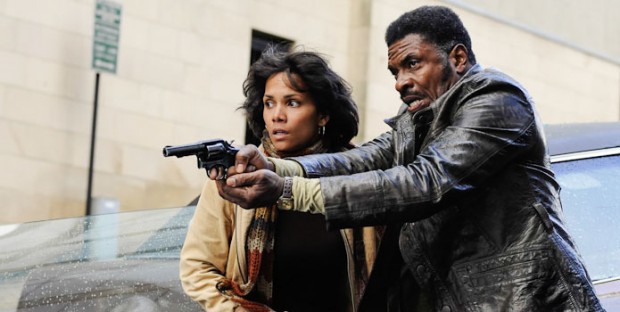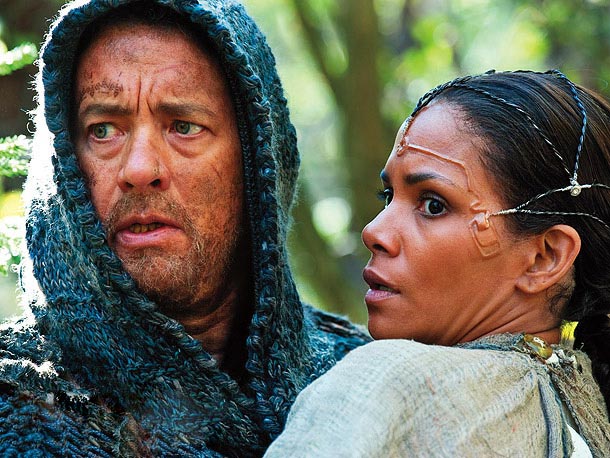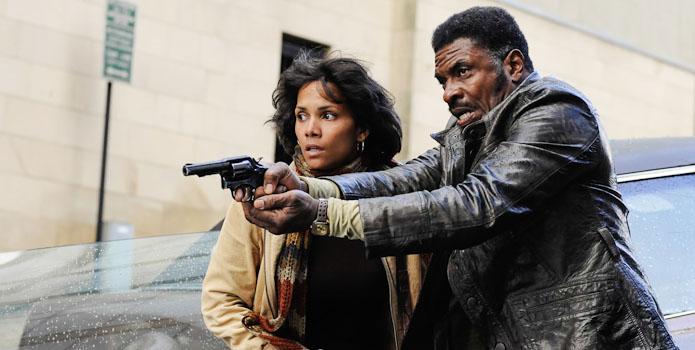
The Wachowskis and Tom Tykwer are going to finally unveil what many, including the author, called unfilmable as their adaptation of David Mitchell‘s Cloud Atlas is set for a premiere this month at TIFF. We already got an epic trailer, but now more details on the process of bringing this six-generation-spanning novel to big screen have been revealed. I encourage everyone to head over to the New Yorker, where they recently published an eight-page article on nearly the entire process, full of fascinating details, but we’ll dive into some of the major ones below.
The duo first picked up the idea of adapting the novel thanks to Natalie Portman, who was reading the book on the V for Vendetta set. They read and loved it and passed it along to Tom Tykwer, who felt the same desire work on this project, but that was back in 2006. All were in between projects, so they finally got around to working on the script in February 2009. Check out a quote below on the biggest challenge in adapting the script, including details on how exactly the film will be structured.
The main challenge was the novel’s convoluted structure: the chapters are ordered chronologically until the middle of the book, at which point the sequence reverses; the book thus begins and ends in the nineteenth century. This couldn’t work in a film. “It would be impossible to introduce a new story ninety minutes in,” Lana said. The filmmakers’ initial idea was to establish a connective trajectory between Dr. Goose, a devious physician who may be poisoning Ewing, in the earliest story line, and Zachry, the tribesman on whose moral choices the future of civilization hinges, after the Fall. They had no idea what to do with all the other story lines and characters. They broke the book down into hundreds of scenes, copied them onto colored index cards, and spread the cards on the floor, with each color representing a different character or time period. The house looked like “a Zen garden of index cards,” Lana said. At the end of the day, they’d pick up the cards in an order that they hoped would work as the arc of the film. Reading from the cards, Lana would then narrate the rearranged story. The next day, they’d do it again.
 The sibling duo went on to explain how the film is their way of “getting back to the spectacle of the sixties and seventies, the touchstone movies” and namely, Stanley Kubrick‘s sci-fi classic 2001: A Space Odyssey. Not only was the film a driving force for them to become filmmakers, but when Lana went to meet the eventual star of the film, Tom Hanks, she saw a poster of the film in his office and said the final creation will hopefully be a mix of Moby Dick and Kubrick’s masterpiece.
The sibling duo went on to explain how the film is their way of “getting back to the spectacle of the sixties and seventies, the touchstone movies” and namely, Stanley Kubrick‘s sci-fi classic 2001: A Space Odyssey. Not only was the film a driving force for them to become filmmakers, but when Lana went to meet the eventual star of the film, Tom Hanks, she saw a poster of the film in his office and said the final creation will hopefully be a mix of Moby Dick and Kubrick’s masterpiece.
He instantly agreed to the project and not only that, but down the road when the head of Focus Features, James Schamus, read the script it “had brought back what it was like to see 2001 for the first time.” He added that, “they’ve managed to keep almost every little block of storytelling a cliffhanger. They’ve managed to make you feel the kind of propulsive movement that makes you want to keep coming back.”
The article also dives deep into the Wachowskis’ history of growing up and becoming filmmakers as well as their side project Cobalt Neural 9, which they used as an escape when Cloud Atlas wasn’t coming together. That project, which is on the backburner now, “had grown out of their frustration with the Bush Presidency and the wars in Iraq and Afghanistan,” as the film features interviews taking place in 2090 and looking back at this time period.
Jumping back to Cloud Atlas, we also learn more about how financing came together and how WB originally modeled this film based on Darren Aronofsky‘s The Fountain and eventually cowered at the initial $125 million budget, but Lana chimes in that “originality cannot be economically modelled.” Despite a rough time selling at Cannes 20111, they finally found financing from a number of different sources after dropping the production budget to $80 million, still one of the most expensive independent films ever, and as we can see, the film is finally completed.
With a cast of Halle Berry, Susan Sarandon, Jim Broadbent, Hugh Grant, Hugo Weaving, and Doona Bae, its confirmed that the Wachowskis handled production on the 19th century story, as well as the future stories based in Korea and Hawaii, while Tykwer grabbed the Belgium-set 1930s story, the California-set 1970s story and the present day UK story. In terms of sheer ambitious, this article has me infinitely excited as to what the final production holds. I’ll end with a response New Yorker writer Aleksandar Hemon had after watching the first cut and make sure to check back for our take as TIFF kicks off.
[Cloud Atlas] seemed poised to usher audiences into an era of imaginative adventure filmmaking beyond the mindless nihilism of “Transformers” or “Resident Evil.” The movie carefully guided the viewer through its six story lines with just enough intriguing unfamiliarity, while succeeding—nearly miraculously—in creating a sense of connectedness among the myriad characters and retaining Mitchell’s idea of the universality of love, pain, loss, and desire. Doona Bae, who plays (among others) Sonmi~451, the “fabricant” who evolves into full humanity in 2144, was a revelation. The Wachowskis’ formal boldness, balanced with heartwarming redemption, was a perfect match for Tykwer’s precise filmmaking and gorgeous music. (He and his musical partners composed the “Cloud Atlas” soundtrack before shooting even started.) In addition to applause at this screening, there were tears and triumphant hugs. The Wachowskis and Tykwer were visibly touched. Their rocket ship had reached its cosmic port.
Cloud Atlas premieres at TIFF and then hits theaters on October 26th.

